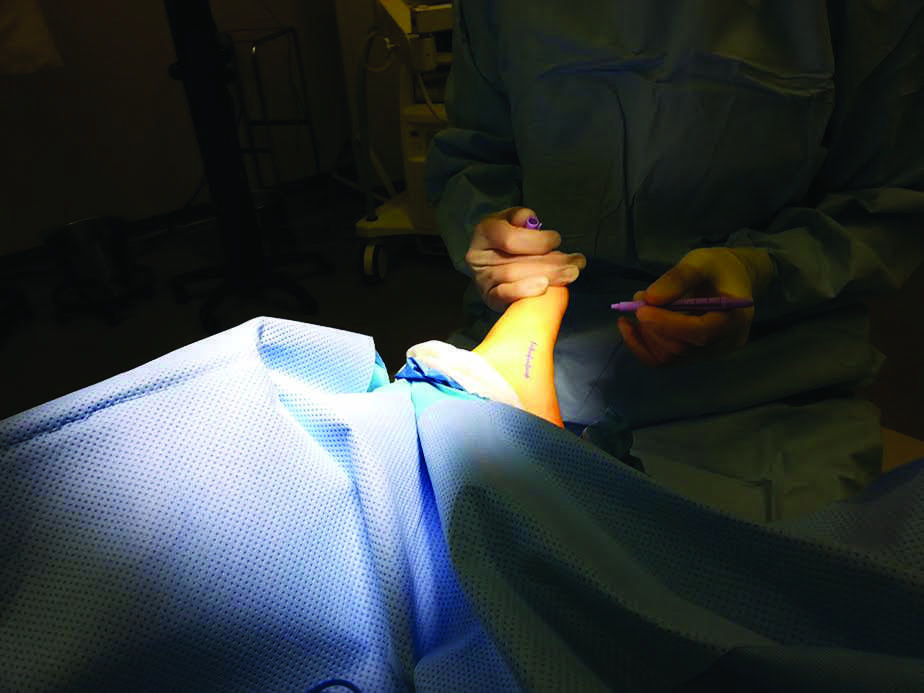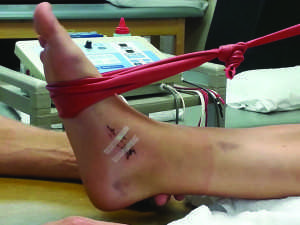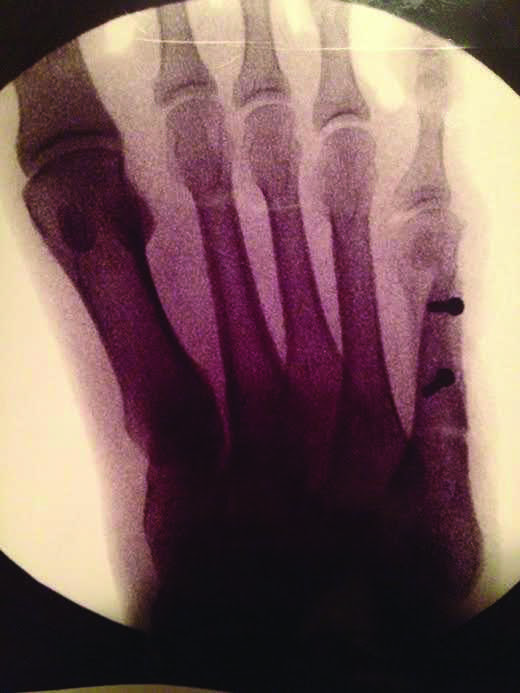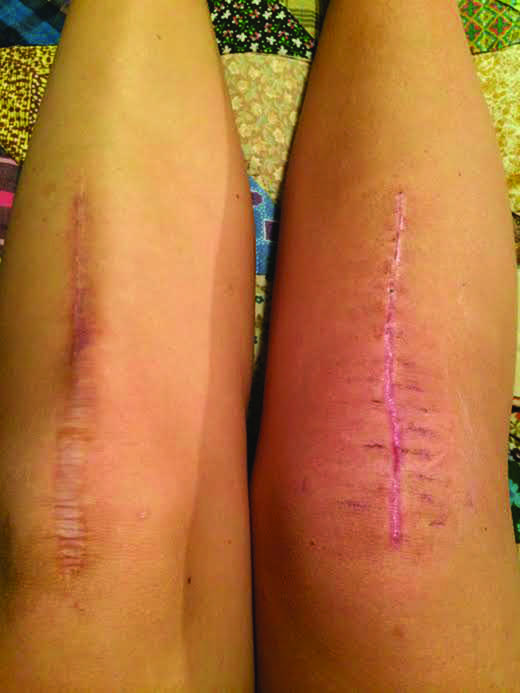Your donation will support the student journalists of Iowa City High School. For 2023, we are trying to update our video and photo studio, purchase new cameras and attend journalism conferences.
Under the Knife
Over the past year, four City High students have undergone surgery and tell their stories of coping with injury, illness and recovery.
February 14, 2014
Eve Small
INJURED: Both Feet
After spending hours on the court practicing her serve, swing, and form, Eve Small ‘15 grimaces as she glances at her feet, feeling a painful ache slowly spread from her arches to the back of her heels reminding her that in just a few short months she will no longer be playing tennis, but spending her off season wearing a boot on both feet. Small is one of a handful students that have undergone a surgery at City High.
“It drove me crazy not being active, getting back into it a little bit you try to push yourself, forgetting that you’ve had this surgery and it’s terrifying,” she said. “I didn’t know what to do with myself, tennis had kind of been my life since I was four and suddenly stopping was a big change.”
This past September and October, Small underwent two kidner procedures, a surgery to remove extra bones in the bottoms of both of her feet, that she has had since she was born.
The extra bones caused her posterior tibial tendons to connect in an incorrect way which caused her pain and became inflamed when she played tennis.
In the surgeries, her posterior tibial tendon was disconnected from the extra bone (which was taken out) and re-attached correctly.
“It was difficult when I stopped playing, if that makes sense,” Small said. “When you’re playing you kind of forget about the pain and ignore it or choose to ignore it but the once you stop, it hits you. Playing tennis didn’t necessarily make my feet worse, but it irritated them. It would just get inflamed and really achy and sore.”
After having the first surgery on her right foot, Small was put in a splint for a few days and later a boot for a month and a half. While recovering from her first surgery, she underwent her second surgery on her other foot and was put in another boot for one month. During her recovery process, Small attended physical therapy sessions three to four times a week.
“Having the surgery took me out of tennis for a while,” she said. “But now I think [my playing] is going to be better than it ever was.”
Gabe Caballero
INJURED: Left Leg
On November 14th, 2013, senior Gabe Caballero was involved in a car accident, leading to him spending 12 days in a hospital and having three surgeries on his left leg and more to come in the future.
“The first two days in the hospital I don’t remember anything, there was so much going on,” Caballero said. “I really just sat there and didn’t do much, watched a lot of football, didn’t talk much. I had sleeping issues.There was one point when I was in the hospital that I was in so much pain, it was the most excruciating pain that I’ve ever had in my life for 15 minutes and that’s just something that you don’t want to go back to ever.”
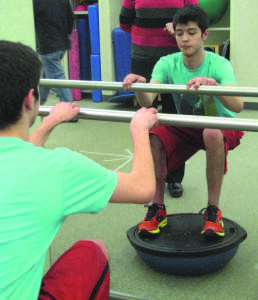
Injuries that he sustained included severing his MCL, ACL, PCL and LCL which completely dislocated his knee. This lead to tearing his Popliteal Artery, the main artery in the leg, which lead to poor blood flow to his foot and losing four units of blood, close to the six units a human is capable of losing before dying.
“They almost amputated my foot, they were approved to amputate,” Caballero said. “My foot died. When I went into surgery it was white, it was gone. I should’ve had nerve damage but I didn’t. So when my mom got to the hospital the first thing she signed were the amputation forms.”
The first thing that was done when Caballero reached the hospital was a bypass surgery on his Popliteal Artery, removing a vein from his right leg and connecting it in his left leg. At this point blood flow had returned to his foot so amputation was not necessary.
After the seven hour-long bypass surgery, an external fixator was attached to his femur and tibia with metal rods. During this time Caballero’s lower leg and knee had swelled to 17” in circumference. To release the pressure Doctors performed a Bilateral fasciotomy on his lower leg that was covered with a skin graft from his upper leg eight days later.
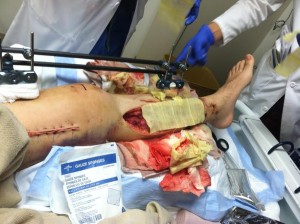
Once Caballero woke up from the surgeries, he was told he would no longer be able to walk until his fixator was removed and would not be able to run for at least four months.
One month and one week after the accident, the fixator was surgically removed and Caballero was allowed to start physical therapy. He began going twice a week although he was not quite able to walk yet. Due to these injuries, Caballero was out for his senior year of swimming.
“I really wanted to be swimming, I look forward to swimming,” he said. “It’s my favorite sport and it was really disappointing that I couldn’t swim anymore”
About a month after the fixator was removed, however, Caballero was cleared to get in the pool again.
“When I found out I could go back and do swimming as physical therapy I was really happy about it because I could still practice with the team,” Caballero said. “So right now I’m just waiting on a doctor’s note to get me cleared to practice normally with the team because the school has to know that there’s a possibility that I could dislocate my knee.”
Although he is now walking with a brace and back to swimming, Caballero will be having reconstructive surgery on his knee at some point within the next six months and will need to have his bypass re-done every eight years in the future.
“Of course it’s changed me, there was a chance that I could’ve died that night and that thought consumed me for a long time,” Caballero said. “I can’t say that it doesn’t still. Being that close definitely changes you and there is a thought inside of you that there’s a reason I’m alive now. That’s the worst part about it.”
Ana Clemons
INJURED: Both Feet
Along with Small, Ana Clemons ‘14 has had surgeries on both her feet this past year as well. In her case, running was the cause for the surgery.
“I had surgery on both of my feet because of running, they got worn down and basically the pressure on my feet moved my bones over so they had to put screws in them and reposition both feet,” Clemons said. “It was painful running on them, but it was so worth it.”
Over the past three years of participating in cross country and track, the pressure of the impact of running began wearing down the bones in Clemons’ feet, her pinky toe bones and her metatarsal on her left foot were being bent inwards. Last winter she went to the doctor and was told she would have to have surgery done so in the beginning of November, 2013, Clemons had her first surgery on her left foot.
“It’s been like this for at least three years but I told them that I wanted to finish my last season of cross country so they waited until that was over in the fall,” she said. “It got worse as time went on. It got more and more bent, and they told me that would happen but I didn’t really care as long as it could be fixed, I just wanted to run my last year.”
After her first surgery Clemons was on crutches for two weeks and a boot for four. Three days later she had her second surgery done on her right foot and was on crutches for a week and a boot for three weeks.
When she came out of surgery, Clemons was told she would have a four month-long recovery and might not be able to run track.
“It was really hard for me to because I put so much focus and effort into doing cross country,” Clemons said. “And it was really hard to know that I can’t run, that I can’t choose to run. It sucks to not be able to run. So that’s probably what’s been hardest but I’m glad I did it because I hope to eventually be able to run like I used to.”
Kelly Sabers
INJURED: Knee
In Kelly Sabers ‘14’s case, doctors do not know the specifics of her injury. Some say it could be hereditary while others say it could have been caused by the medicine she took for her seizures when she was younger. But in the past four years, Sabers has had knee surgery on both legs.
“I had this same surgery done freshman year, so I kind of knew what to expect with the surgery,” Sabers said. “I’m not really sure what’s wrong with my knees, they think it’s genetic, but I don’t really know exactly how I got it.”
This past November, Sabers had an anteromedialization of the tibial tubercle done on her right knee. In this surgery, a piece of her tibia where the patella tendon connects was cut and moved up and over to move her kneecap higher in order to not have as much pressure on it. Her kneecap and tibia are now held in place with three screws.
“How [the doctors] put it was, [my cartilage] was like butter and it’s supposed to be like a pillow,” she said. “So it was basically almost down to bone on bone.”
After the surgery, Sabers was out of school for a week, upon which she could not put any pressure on her leg. She was told that she would not be able to bear weight for four to six weeks. Three weeks after the surgery however, she began going to physical therapy three times a week.
“The worst thing was that after the surgery my quad shut off so I had to basically re-teach it to work,” Sabers said. “And so I’ve been going to physical therapy and doing electric stem cell therapy each time for 15 seconds to wake up the muscle.”
Having these surgeries has lead to Sabers having limited participation in sports, mainly track and field. Her freshman year she had her first surgery on her left leg, taking her out for the season. During her junior season she had to have her screws removed and this season Sabers will still be recovering during the beginning of the season.
“This year when I decided I’d get the surgery, I was bummed,” Sabers said. “But then, I had to think of the rest of my life. I know track seems like a big part of my life right now, but I have to think about if I want to be healthy the rest of my life.”
Although Sabers has not been able to fully participate in track, getting these surgeries done will improve her activity in the long run.
“They told me that I’m going to have to limit what I do for the rest of my life, you know, not run marathons or long distances, and no squatting just to preserve my knee as much as possible because if I don’t, I’ll have to get a knee replacement,” Sabers said. “It was a bummer but then I tried to think of people with worse situations than me, I just have to think of the bigger picture.”
